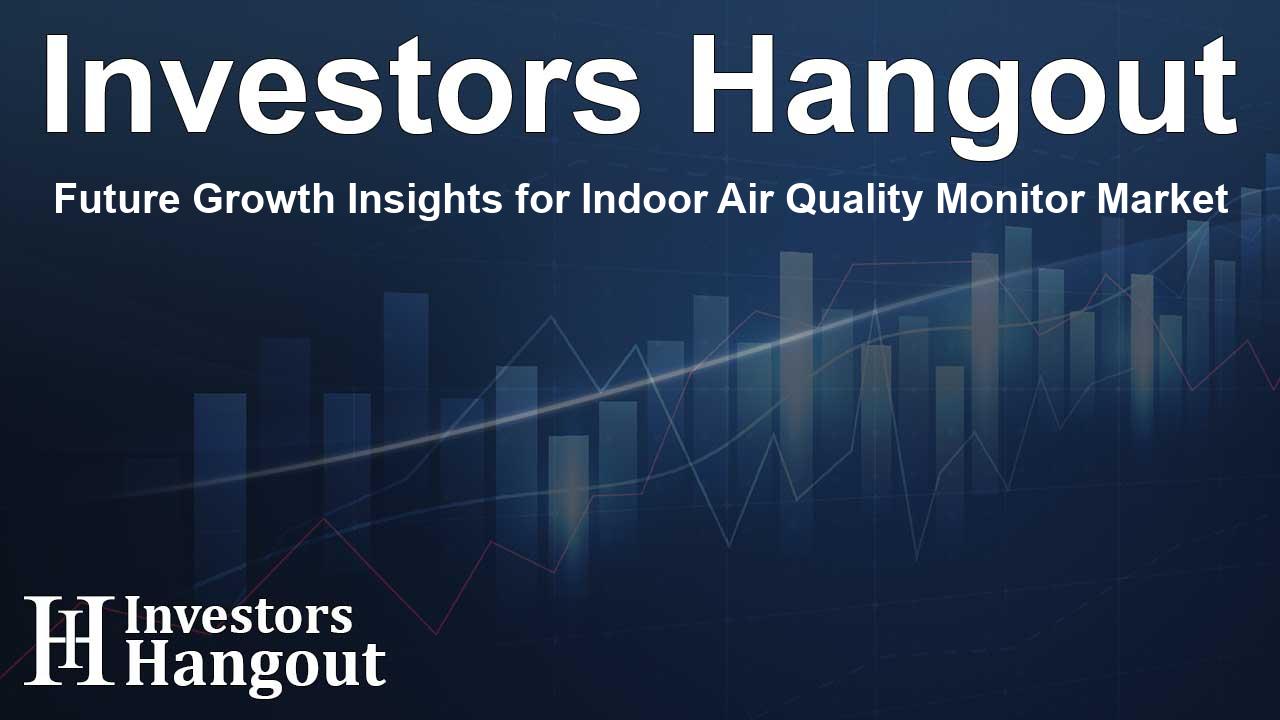Future Growth Insights for Indoor Air Quality Monitor Market

Indoor Air Quality Monitor Market: Trends and Projections
The Indoor Air Quality Monitor market is gaining significant momentum, with recent insights revealing a compelling growth trajectory. Reports indicate that this market was valued at approximately USD 5.03 billion and is projected to soar to USD 9.38 billion in the coming years. This impressive growth reflects a compound annual growth rate (CAGR) of 8.09% from 2024 to 2032, signaling an increasing emphasis on indoor air quality.
The Driving Forces Behind Market Expansion
Several key factors contribute to the rapid growth of the Indoor Air Quality (IAQ) Monitor market. Firstly, the alarming rise in respiratory diseases has prompted both consumers and businesses to prioritize air quality in their environments. With the realization that poor air quality can lead to productivity losses of up to 12% in workplaces, there is a heightened demand for effective monitoring solutions in both residential and commercial settings. Additionally, the global push towards energy-efficient and sustainable building practices increases the value of IAQ monitoring in smart building systems, integrating seamless technology to ensure a healthier atmosphere.
Regional Market Insights: North America and Asia Pacific
In 2023, North America emerged as the dominant player in the Indoor Air Quality Monitor market, capturing approximately 40% of the global revenue share. The region's high adoption rates can be attributed to stringent regulatory frameworks and a growing awareness of health issues related to indoor air quality. Initiatives like the EPA IAQ guidelines have further accelerated the adoption of these monitoring systems in various applications ranging from homes to industrial environments. Conversely, the Asia Pacific region is set to experience the fastest growth, driven by urbanization and industrialization trends that are resulting in deteriorating air quality. Countries such as India and China are enforcing stricter regulations and investing in smart city projects to bolster market expansion.
Market Scope and Key Segments
The scope of the Indoor Air Quality Monitor market encompasses several attributes including market size, segments analysis, competitive landscape, and forecasting outlook. The market is categorized by various segments such as pollutant types, product types, and end-users. The products can range from portable to stationary monitoring systems, ensuring a comprehensive approach to air quality management.
Pollutant Types and Their Impact on Market Dynamics
The segmentation by pollutant type reveals that chemical sensors currently hold significant market share, accounting for 54% of the revenue. These sensors effectively detect air pollutants such as volatile organic compounds (VOCs) and carbon monoxide. However, physical sensors are poised for rapid growth due to the increasing demand for real-time monitoring capabilities. This demand is fueled by the extensive integration of IoT technology into smart homes, allowing individuals to easily track their indoor air quality.
End-Use Applications Shape Growth Trajectories
Regarding end-use applications, the commercial sector leads the market, comprising 45% of the overall revenue. The growing awareness of employee health and compliance with regulatory standards has spurred the adoption of advanced IAQ monitoring systems across various industries, including healthcare, commercial buildings, and educational institutions. Significantly, the industrial segment is forecasted to display robust growth as regulatory norms become stricter, pushing companies to adopt smart monitoring solutions to safeguard their workforce and enhance operational efficiency.
Notable Industry Players and Innovations
The market features a competitive landscape with key players including Thermo Fisher Scientific Inc., Siemens AG, and Honeywell International Inc., among others. These companies are at the forefront of innovation, continually advancing their products to meet the evolving needs of consumers. For instance, in a recent initiative, Panasonic unveiled a new Smart Home Experience Centre focused on seamless integration of air quality solutions with IoT applications, demonstrating the trend towards smart living environments.
Frequently Asked Questions
1. What is the projected market size for Indoor Air Quality Monitors by 2032?
It is projected that the market will reach USD 9.38 billion by 2032.
2. What are the main drivers of growth in the Indoor Air Quality Monitor market?
Key drivers include rising respiratory health issues, regulatory pressures, and increased demand for energy efficiency in buildings.
3. Which regions are expected to dominate the market?
North America currently leads the market, but the Asia Pacific is expected to show the fastest growth.
4. What types of pollutants are monitored by IAQ devices?
IAQ monitors detect various pollutants including VOCs, carbon monoxide, and particulate matter (PM).
5. Who are the leading companies in this market?
Key players include Thermo Fisher Scientific, Siemens, and Honeywell, focusing on innovative air quality solutions.
About The Author
Contact Riley Hayes privately here. Or send an email with ATTN: Riley Hayes as the subject to contact@investorshangout.com.
About Investors Hangout
Investors Hangout is a leading online stock forum for financial discussion and learning, offering a wide range of free tools and resources. It draws in traders of all levels, who exchange market knowledge, investigate trading tactics, and keep an eye on industry developments in real time. Featuring financial articles, stock message boards, quotes, charts, company profiles, and live news updates. Through cooperative learning and a wealth of informational resources, it helps users from novices creating their first portfolios to experts honing their techniques. Join Investors Hangout today: https://investorshangout.com/
The content of this article is based on factual, publicly available information and does not represent legal, financial, or investment advice. Investors Hangout does not offer financial advice, and the author is not a licensed financial advisor. Consult a qualified advisor before making any financial or investment decisions based on this article. This article should not be considered advice to purchase, sell, or hold any securities or other investments. If any of the material provided here is inaccurate, please contact us for corrections.
